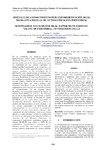Sistemas de conocimiento por experimentación real mediante células de automatización industrial
Title
Sistemas de conocimiento por experimentación real mediante células de automatización industrialAlternative Title(s)
Knowledge Systems for Real Experimentation by Means of Industrial Automation CellsDate
2018Citation
González, S., Dormido Canto, S., Sánchez Moreno, J. Sistemas de conocimiento por experimentación real mediante células de automatización industrial. En Actas de las XXXIX Jornadas de Automática, Badajoz, 5-7 de Septiembre de 2018 (pp.784-791). DOI capítulo: https://doi.org/10.17979/spudc.9788497497565.0784 DOI libro: https://doi.org/10.17979/spudc.9788497497565
Versions
http://hdl.handle.net/10662/8660
Abstract
[Resumen] En la actualidad, las amenazas hacia las
infraestructuras críticas están consideradas por la
UE (Unión Europea) así como por otros estamentos
internacionales, uno de los riesgos más graves para
la estabilidad de sus estados, afectando su
disfuncionalidad gravemente a la economía y la
sociedad. Ello se debe, específicamente, a que los
avances constantes en las tecnologías de la
información y las comunicaciones se trasladan a los
Sistemas de Control Industrial (SCI) proporcionando
una gran flexibilidad de interconexión gracias a su
escalabilidad y a modelos con una conectividad cada
vez más simple e intuitiva. El uso de las redes de
comunicación hace que estos sistemas sean
altamente vulnerables, ya que no fueron diseñados
originalmente para este tipo de expansión o formas
de comunicaciones. En sus orígenes fueron
diseñados con el propósito principal de otorgar la
máxima disponibilidad de procesos. Sin embargo,
hoy en día, la disponibilidad sigue siendo su misión
principal. En este trabajo, se presenta el sistema
SICERCAI1, el cual aporta nuevas capacidades de
investigación, desarrollo, simulación y banco de
pruebas del funcionamiento de estos sistemas. A su
vez, otorga capacidades de anticipación del
comportamiento de un sistema en producción
industrial y, como consecuencia directa, altas
capacidades de ciberresiliencia. Como es un sistema
abierto a la interconexión, permite la construcción
de Células de Automatización Industrial (CAI) con
elementos de los diferentes fabricantes de
componentes industriales, pudiéndose agregar al
sistema SICERCAI para cubrir el 100% de las
posibilidades arquitectónicas existentes en la
industria actual. De esta manera se consiguen
recrear entornos industriales de carácter híbrido, siendo este aspecto el que más se asemeja a la
realidad en la industria. [Abstract] This work, by the development of the SIKERCIA1
system, provides new capacities of research,
development, simulation and testing of the
functioning of critical infrastructures, and the
capacity of anticipating the behavior of a system in
industrial production. At the same time, SIKERCIA
provides high capacities of cyber-resilience and also
describes the condition of maturity with regard to the
cybersecurity of the services implemented in
SIKERCIA and catalogued as essential. All the above
is provided by a system that has been tested,
analyzing industrial environments. As it is a system
open to interconnection, it allows the construction of
Industrial Automation Cells using industrial
components from different manufacturers, which can
be added to the SIKERCIA system to cover 100% of
the existing architectural possibilities in the current
industry.
Keywords
Ciberseguridad
SCADA
PLC
Sistemas de control industrial
Infraestructuras críticas
Ciberresiliencia
Células de automatización industrial
Cybersecurity
Industrial control system
Critical infrastructure
Cyber-Resilience
SCADA
PLC
Sistemas de control industrial
Infraestructuras críticas
Ciberresiliencia
Células de automatización industrial
Cybersecurity
Industrial control system
Critical infrastructure
Cyber-Resilience
Editor version
Rights
Atribución-NoComercial 3.0 España
ISBN
978-84-09-04460-3 (UEX) 978-84-9749-756-5 (UDC electrónico)







